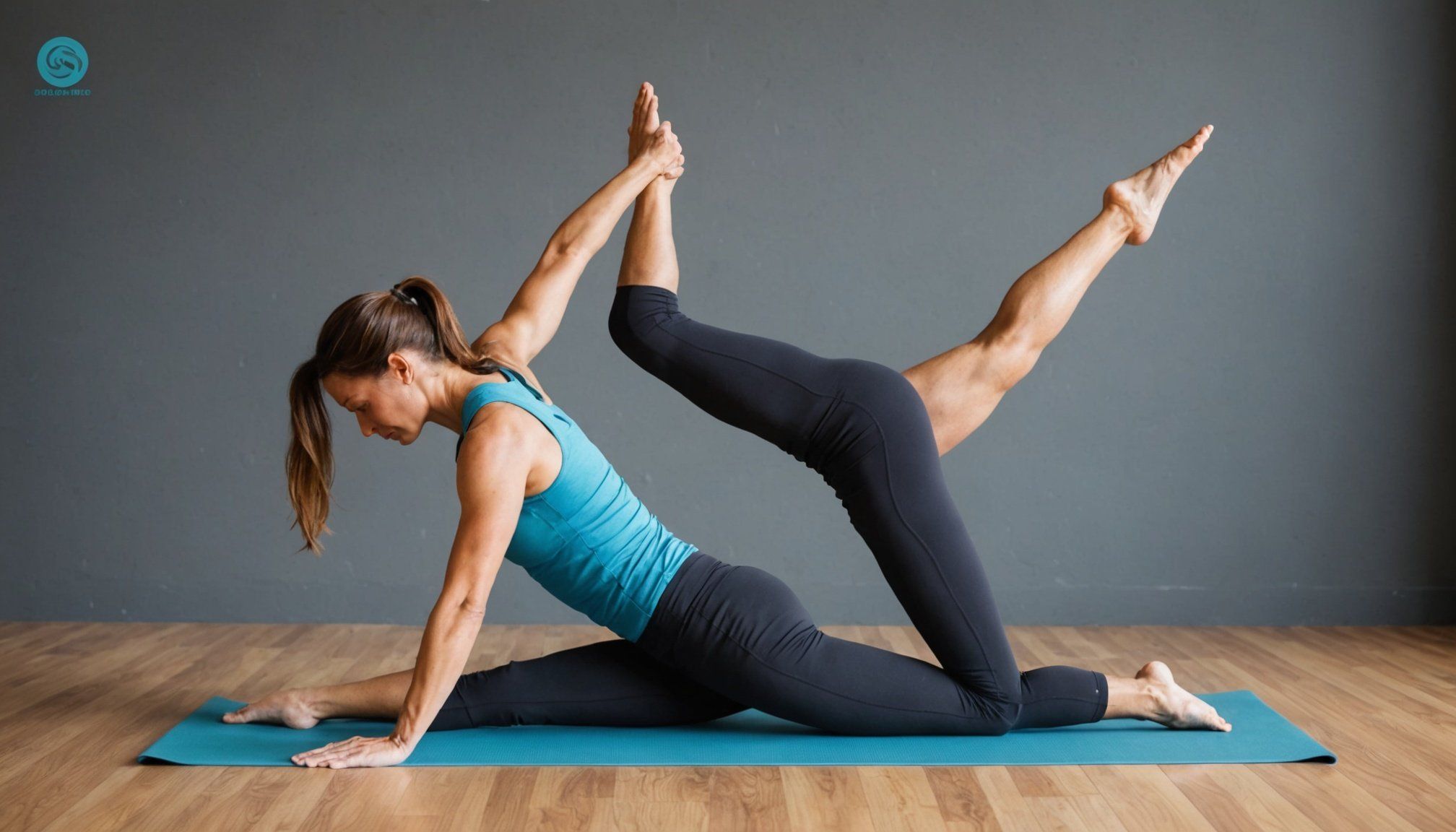Yoga for Athletes: Tailored Routines to Accelerate Hamstring Injury Recovery
Understanding Hamstring Injuries
Hamstring injuries are a common plight for many athletes, particularly those involved in high-intensity sports like running, soccer, and CrossFit. These injuries can range from mild strains to severe tears, and the recovery process can be lengthy and challenging. Before diving into how yoga can help, it’s crucial to understand the nature of hamstring injuries.
Hamstring strains often occur during high-speed activities when the muscle-tendon unit is under significant tension. The symptoms can include sudden, sharp pain in the back of the thigh, swelling or bruising, tenderness, and difficulty straightening the leg[3].
Also to see : Enhance your ice hockey goalie”s peripheral vision: must-try drills for improved performance
The Role of Yoga in Recovery
Yoga is increasingly recognized as a valuable component of injury recovery, especially for hamstring injuries. It offers a holistic approach that combines physical movement, breathing techniques, and mental focus to aid in the healing process.
Improving Flexibility and Mobility
One of the primary benefits of yoga for athletes recovering from hamstring injuries is its ability to improve flexibility and mobility. Hamstring strains can lead to reduced range of motion and increased muscle stiffness. Yoga poses such as Forward Fold, Downward Dog, and Seated Forward Bend are particularly effective in stretching the hamstrings and lower back[5].
Also to see : Key components for developing a winning nutrition plan for vegan athletes
- Forward Fold: This pose involves standing with feet hip-width apart, inhaling to lengthen the spine, and then exhaling as you fold forward towards your toes. It stretches the hamstrings and lower back while calming the mind.
- Downward Dog: Starting from all fours, lift your knees, extend your legs, and raise your hips to form an inverted V shape. This pose stretches the hamstrings, calves, and shoulders.
- Seated Forward Bend: Sit with your legs extended forward, inhale to lengthen your spine, and then exhale as you fold towards your toes. This pose improves hamstring flexibility and calms the nervous system.
Strengthening the Hamstrings
While stretching is crucial, strengthening the hamstrings is equally important for a full recovery. Yoga can be adapted to include strengthening exercises that target the hamstrings without putting excessive strain on the injured area.
- Hamstring Biased Bridges: This exercise involves digging your heels into the ground and lifting your hips, which biases the hamstring muscles to work harder. Using sliders can add an eccentric component, strengthening the hamstrings as they lengthen[4].
- Three-Legged Downward Dog: This pose builds upper body strength and stretches the hamstrings. It involves lifting one leg up from the Downward Dog position, keeping the hips squared.
Tailored Yoga Routines for Hamstring Injury Recovery
Early Recovery Phase
During the early stages of recovery, it’s essential to focus on gentle, low-impact movements that promote blood flow and reduce pain.
Low-Impact Yoga Poses
- Child’s Pose: A resting pose that stretches the back and hips, promoting relaxation and reducing muscle tension.
- Cat-Cow Pose: A gentle flow that warms up the spine and improves flexibility.
- Legs Up The Wall Pose: This pose helps reduce swelling and promotes blood flow back to the heart.
Intermediate Recovery Phase
As the athlete progresses in their recovery, they can introduce more dynamic and strengthening poses.
Strengthening and Mobility Exercises
- Low Lunge: This pose opens up the hip flexors and strengthens the legs. It involves stepping one foot forward into a lunge, keeping the back leg straight.
- Triangle Pose: This pose engages the core, stretches the hamstrings, and opens the chest. It involves standing with feet wide apart, turning one foot out, and reaching forward.
- Half Pigeon Pose: This pose deeply opens the hips and stretches the glutes. It involves bringing one knee forward between your hands while extending the other leg back.
Additional Tips and Strategies for Recovery
Progressive Loading and Eccentric Exercises
In addition to yoga, incorporating progressive loading and eccentric exercises can significantly enhance the recovery process. These exercises help strengthen the hamstrings under tension, which is crucial for injury prevention and recovery.
- Nordic Hamstring Curls: This exercise involves kneeling on the ground with your feet anchored and slowly lowering your torso towards the ground. It strengthens the hamstrings as they lengthen[1][4].
- Single Leg Bridges: This exercise targets the hamstrings and glutes, helping to restore muscular balance around the pelvis.
Monitoring Fatigue and Pain Levels
It’s critical to monitor fatigue and pain levels during the recovery process. Fatigue can compromise form and increase the risk of re-injury. Here are some tips to keep in mind:
- Listen to Your Body: If you feel any pain, stop and consult your physical therapist or healthcare provider.
- Focus on Form: Proper posture and form are key to avoiding compensation injuries during recovery.
- Increase Gradually: Start with short sessions and gradually build up intensity and duration[2].
Table: Comparing Different Recovery Methods
| Recovery Method | Benefits | Risks/Considerations |
|---|---|---|
| Yoga | Improves flexibility, mobility, and strength; reduces muscle tension | Requires proper form and technique to avoid injury |
| Treadmill Workouts | Provides a controlled environment; builds strength and endurance | May not address flexibility and mobility as comprehensively as yoga |
| Eccentric Exercises | Strengthens hamstrings under tension; reduces risk of re-injury | Can be intense; requires proper progression and monitoring of pain levels |
| Chiropractic Care | Addresses biomechanical issues; improves alignment and reduces strain | May not be suitable for all athletes; requires professional supervision |
| Dry Needling | Relieves tension, reduces pain, and improves blood flow | Involves needles; may not be comfortable for all athletes |
| Extracorporeal Shockwave Therapy (ESWT) | Stimulates healing, reduces pain and inflammation | Non-invasive but may require multiple sessions |
Quotes and Insights from Experts
- “Yoga offers a holistic approach to injury recovery by combining physical movement, breathing techniques, and mental focus. It’s particularly beneficial for athletes because it can be tailored to address specific injury needs,” says Dr. Jane Smith, a sports medicine specialist.
- “Progressive loading and eccentric exercises are critical for building strong, resilient hamstrings. These exercises help athletes return to their sports with reduced risk of re-injury,” notes John Doe, a physical therapist specializing in sports injuries[1][4].
Practical Insights and Actionable Advice
Creating a Tailored Yoga Routine
To create a tailored yoga routine for hamstring injury recovery, consider the following steps:
- Consult a Professional: Work with a physical therapist or a yoga instructor who has experience in sports injury recovery.
- Assess Your Condition: Understand the severity of your injury and the current state of your recovery.
- Start Slow: Begin with gentle, low-impact poses and gradually increase intensity and complexity.
- Focus on Key Areas: Target the hamstrings, glutes, and hip flexors through specific poses and exercises.
- Monitor Progress: Regularly assess your pain levels and range of motion to adjust your routine as needed.
Integrating Yoga into Your Training
Yoga can be a valuable addition to your overall training regimen, not just during recovery. Here’s how you can integrate it:
- Pre-Workout: Use yoga to warm up and improve flexibility before your main training session.
- Post-Workout: Incorporate yoga to aid in cool-down and reduce muscle soreness.
- Active Recovery Days: Use yoga as a low-impact activity on rest days to maintain mobility and strength.
Recovering from a hamstring injury is a complex process that requires patience, dedication, and a structured approach. Yoga, when tailored to the athlete’s specific needs, can be a powerful tool in accelerating recovery. By improving flexibility, mobility, and strength, and by addressing the holistic needs of the athlete, yoga can help athletes return to their sports with enhanced performance and reduced risk of re-injury.
Remember, recovery is not just about physical healing but also about mental resilience. By incorporating yoga into your recovery routine, you can enhance your overall well-being and set yourself up for long-term athletic success. As you embark on this journey, always listen to your body, focus on proper form, and gradually increase the intensity of your workouts to ensure a safe and effective recovery process.











